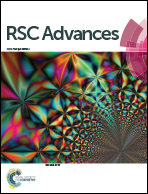β-Substituted triarylborane appended porphyrins: photophysical properties and anion sensing†
Abstract
β-Substituted triarylborane porphyrins were designed and synthesized by the Pd-catalyzed Sonogashira cross-coupling reaction. The incorporation of triarylborane unit results in a red shifted absorbance and fluorescence. The sensing ability of these porphyrins was studied for different anions. The triarylborane porphyrin 4 and 5 selectively detects fluoride ions as shown by the UV/vis absorption and fluorescence titration experiments. The binding constants for triarylborane porphyrin 4 and 5 in dichloromethane at 25 °C were found to be 1.0 × 106 M−1 and 5.0 × 105 M−1 respectively.


 Please wait while we load your content...
Please wait while we load your content...